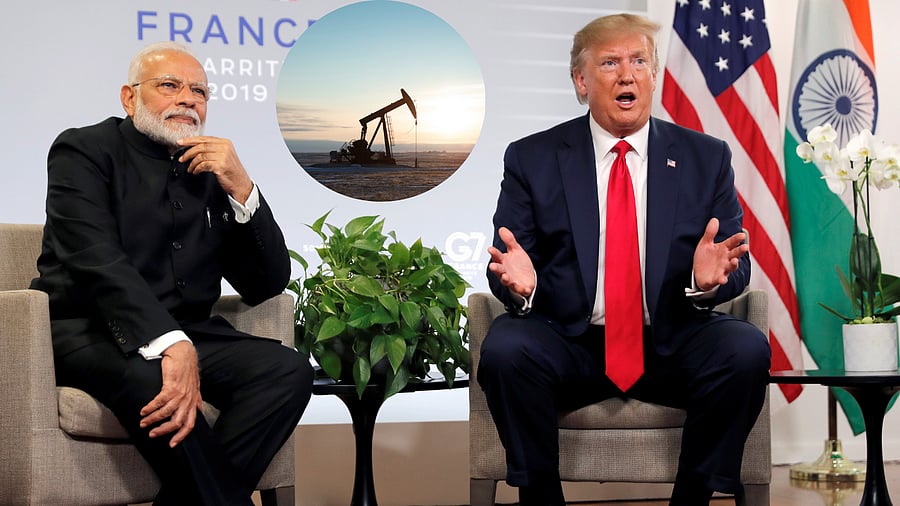
Prime Minister Narendra Modi with US President Donald Trump. (Inset: An oil rig in North America).
Credit: Reuters File Photo; iStock
With the mantra of ‘Drill baby drill’, and expedited regulatory clearances, United States President Donald Trump and his followers believe he can unleash a wave of increased US oil and gas production. Whether we in India believe that or not, decisions made in Washington will impact our lives.
Almost 90% of our crude oil requirements come from abroad. Oil makes up 25-30% of our total import bills, and imports keep increasing every year. Despite efforts at energy transition, oil and natural gas remain vital not just for transport but for cooking, electricity, chemicals, pharmaceuticals, plastics, etc. — all the stuff of modern civilisation. Not to forget defence and national security.
The US is already the world’s largest oil producer, with output at record levels of over 13.2 million barrels per day (bpd). This is 70% higher than a decade ago when the surge in production of shale/tight oil and gas really took off in the US. This kept global prices in check, though OPEC+ made repeated efforts to raise prices by curtailing output. Despite this favourable external factor, petrol and diesel prices in India remained high throughout. But that is because nearly half the cost consists of taxes being squeezed out of us citizens by the Union and state governments!
In the US, petrol prices are a more politically sensitive issue. Trump campaigned with the promise of lowering inflation in fuel costs by increasing oil production as an emergency, which he has now declared. However, investment decisions are not made in the White House, but in the boardrooms of oil companies; and at present, the latter seem to want to maximise shareholder returns, not production. Market analysts say that US output may rise by only 300,000 bpd this year, based on earlier investments in advanced drilling techniques. Which is why Trump is now asking Saudi Arabia, which has 3 million bpd spare capacity, to increase production!
In 2022, Western sanctions imposed on Russian oil led to a spike in prices of globally traded oil. India’s place in the Indo-Pacific strategies of the US and the European Union, and some astute diplomacy, enabled us to retain access to relatively cheap oil imports from Russia without getting entangled in sanctions. However, the outgoing Joe Biden administration left with a parting kick a few weeks ago, by extending sanctions to two of the largest Russian oil exporters, and tightening the web of sanctions against shipping and insurance for carriage of Russian oil. Whether we can continue buying Russian oil with hefty discounts as we did in 2024 (bringing our total import bill down from $157billion in 2023 to $132bn) is not clear. But our oil importing companies have already reduced purchases.
Lifting of Western sanctions on Russia, will require a negotiated settlement of the Ukraine war; and is likely to take time. Meanwhile, the exclusion of Russian oil from world markets will keep prices elevated, putting pressure on large importers like India and China. Oil markets are now keeping a wary eye on the Trump administration’s evolving policy on Iran.
So far Trump has surprised Washington by excluding some of the prominent anti-Iran hawks who want to tighten sanctions on the Iranian economy. If these elements, whose aspiration is regime change in Tehran, were to get access to positions of power, West Asia could face greater tensions, perhaps even another round of war. Market analysts believe such a scenario could send oil prices spiralling upwards, to $100 per barrel from the present $70-75 range.
India today imports almost 5 million bpd and has the dubious distinction of being the highest source of incremental demand; i.e. the country importing the largest number of additional barrels. A crisis in the Gulf would raise oil prices sharply, drive up the cost of living even higher, and throw budgetary assumptions (currently being cooked in New Delhi) out of gear. It will increase our trade deficit; with resulting adverse effects on rupee exchange rates raising all import bills.
Diversification of suppliers, and increasing strategic stockpiles are part of a solution. More substantively, we must curtail the overwhelming dependence on imports which are expected to increase to 6 million bpd by 2035; and in the long run reduce the use of oil through faster transition to electric vehicles, as China has done. For over a decade, India’s domestic production has been declining every year due to low investment caused by penal taxes and obstructive regulations strangling our oil industry. Despite declarations of reform, production is now 20% lower than in 2013. A pragmatic minister, Hardeep Singh Puri, is, however, bringing some change. The recent announcement of ONGC roping in BP to enhance production from Mumbai High, marks a step in the right direction.
We also need to recognise that the US drive for higher natural gas production has a new strategic objective. The massive increase in electricity required to feed the phenomenal demand of fast- growing data centres, AI applications, and EVs, has upended calculations of electricity demand growth worldwide. Projected future requirements are shooting upwards. Gas-based power plants are seen as a viable source for a quick increase in large-scale electricity generation. Nuclear and solar energy will also be used; but nuclear is long gestation, and solar requires storage.
As US accelerates huge new ventures into AI, it is also ‘stepping on the gas’! India’s plan to build a gas-based economy is timely. Increased domestic production, and firm supply links from the Gulf should be priorities.
(Ranjan Mathai is former Foreign Secretary of India and High Commissioner to the United Kingdom.)
Disclaimer: The views expressed above are the author's own. They do not necessarily reflect the views of DH.